November 20, 2013 — A new type of "sunrise" dawned above Earth on Nov. 20, 1998, with the launch of the first piece of the International Space Station.
Fifteen years ago Wednesday (Nov. 20), the Russian-built Zarya, or "Sunrise," module, also known as the functional cargo block (FGB), lifted off atop a Proton rocket from the Baikonur Cosmodrome in Kazakhstan to begin the most complex scientific and engineering project in history.
Zarya supported orientation control, communications and electrical power for the emerging outpost. Two weeks after its launch, Zarya was joined on orbit by Unity, the station's first connecting node.
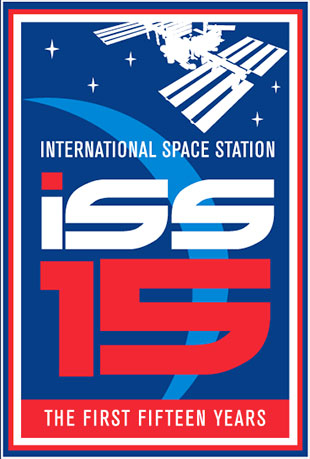
International Space Station: The First Fifteen Years logo (NASA) |
It would take 13 years for the space station's assembly to be declared "complete," although it is still being expanded. Today, the station is an active laboratory with hundreds of science experiments being conducted onboard, advancing humanity's knowledge about how to live in space and how to improve life on Earth.
To mark the 15th anniversary, collectSPACE compiled a countdown of facts about the International Space Station.
15
Sunrises, sunsets
Circling Earth at 17,500 miles per hour (28,000 kilometers per hour) every 92 minutes, the crew members aboard the International Space Station "experience 15 or 16 sunrises and sunsets every day," NASA's Earth Observing System (EOS) Project Office describes.
"The whole station glows with the light of dawn," Canadian astronaut and former ISS commander Chris Hadfield told NPR in a recent interview. "You can see the dawn come across the world towards you."
"Then you go back to work and wait another 92 minutes, and it happens again. It's not to be missed, and I tried to watch as many sunrises and sunsets as the work would allow," he said.
Since the launch of the first "Sunrise" (Zarya), the station has "seen" more than 175,000 sunrises and sunsets.
14
Rooms
The space station today has more livable room than a six-bedroom house — spread across 14 pressurized modules or components.
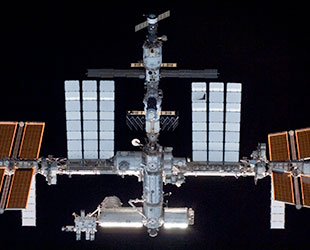
The modules that make up the International Space Station (ISS), as photographed from the space shuttle in May 2010. (NASA) |
There are three laboratories — the U.S. Destiny module, European Columbus module and Japan's Kibo lab — and three connecting nodes (Unity, Harmony and Tranquility). On the Russian side, there are two docking compartments (Pirs and Rassvet), the Zarya FBG and Zvezda service module.
Quest serves as the U.S. operating segment's airlock and the Leonardo permanent multipurpose module (PMM) acts as a closet for storage space. The Kibo module also has its own supply closet (the "JLP") and lastly is the Cupola, a seven-windowed observatory.
The space station's internal volume is about the same as a Boeing 747 jumbo jetliner.
13
Years of continuous residency
It took two years of construction before the space station was ready for tenants. The three-member Expedition One crew, NASA astronaut William Shepard and cosmonauts Sergei Krikalev and Yuri Gidzenko, arrived at the orbiting outpost on Nov. 2, 2000, and the space station has been continuously occupied ever since.
Initially, the station's crew was limited to three people, and for a period of time, that was reduced to only two. Today, the Expedition 38 crew has six members.
Over the past 4,766 days (as of Nov. 20), 88 people have lived aboard the space station as resident crew members, with another 120 or so people visiting the orbiting outpost to help with construction and deliver supplies.
12
Months for the first yearlong mission
To date, the longest expedition on board the International Space Station was 215 days and 8 hours, logged by the Expedition 14 crew of Michael Lopez-Alegria and Mikhail Tyurin from September 2006 to April 2007. Their seven months in space was one and a half months longer than the typical resident crew's stay, which averages about five and a half months in duration.
But as attention turns to sending astronauts out into the solar system, NASA and its international partners are now preparing for the first yearlong stay on the space station.
Beginning in March 2015, NASA astronaut Scott Kelly and Roscosmos cosmonaut Mikhail Korniyenko will live and work on the orbiting complex for 12 months. Their stay will further inform scientists' understanding of how the human body reacts to extended exposure to microgravity.
11
Hundred hours spacewalking
Earlier this month, two cosmonauts ventured outside the space station to mount a camera platform and perform a symbolic relay holding an Olympic torch. It was the 174th spacewalk in the space station's history, bringing the total time spent on ISS extravehicular activities (EVA) to 1,094 hours and 39 minutes, or 45.6 days.
"I remember pre-ISS talking about the hundreds, or more than one hundred, EVAs that are going to be required for assembly [of the space station] and thinking that was a huge mountain to climb," ISS Expedition 16 astronaut Dan Tani said in December 2007 after completing the station's 100th spacewalk.
One hundred and thirteen (113) expedition crew members have donned either U.S. EMU or Russian Orlan suits to work on assembling and maintaining the space station.
10
Space agencies sending astronauts
Fifteen nations partnered to build the International Space Station — the U.S., Russia, Japan, Canada and members of the European Space Agency (ESA) — but the people who have visited the ISS have not been limited to those countries.
In addition to NASA, Roscosmos, the Japan Aerospace Exploration Agency (JAXA), Canadian Space Agency and ESA, astronauts have visited the outpost representing five other space agencies, including France's CNES, Brazil's AEB, Malaysia's Angkasa, South Korea's KARI and Italy's ASI.
9
Hundred, 25 thousand pounds in orbit
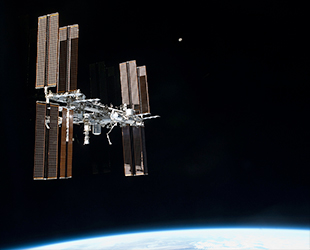
The moon is seen above the International Space Station (ISS) in this photo taken from the space shuttle in July 2011. (NASA) |
When Zarya launched in 1998, it weighed 42,600 pounds (19,300 kg). A decade and a half later, the International Space Station now masses almost one million pounds — 925,000 pounds (420,000 kg).
The station is the largest spacecraft ever assembled or flown in space, spanning the length and width of an U.S. football field.
8
Space tourist flights
Not every individual to fly to the station did so under the auspices of a country or space agency. Seven so-called "space tourists," or "spaceflight participants," funded their own multimillion dollar trips to the space station under an agreement with Roscosmos and the U.S. space tourism agency Space Adventures.
California businessman Dennis Tito was the first to pay his own way to the station in 2001. Following Tito into orbit were South African software developer Mark Shuttleworth, New Jersey entrepeneur Gregory Olsen, Iranian-American engineer Ahousheh Ansari, Hungarian-American Microsoft Office inventor Charles Simonyi, second-generation U.S. astronaut and computer game pioneer Richard Garriott and Canadian Cirque du Soleil co-founder Guy Laliberte.
Simonyi enjoyed his first space trip in 2007 so much that he returned for another flight two years later.
7
Visiting vehicles
Zarya's launch began the effort, but it wasn't until NASA's space shuttle delivered and mated the Unity module that the International Space Station was really born.
The shuttle fleet was critical to the assembly of the space station, delivering to orbit the truss segments that formed the outpost's backbone, as well as most of the modules. When the ISS was completed, the orbiters were retired.
Six other spacecraft have and continue to supply and staff the station.
Since Expedition 1 in 2000, Russia's Soyuz has been the primary means for astronauts and cosmonauts to travel to and from the outpost. Similarly, the station's primary cargo craft has been Russia's unmanned Progress craft, which on Nov. 25 will lift off for the 53rd flight to the station.
JAXA's H-II Transfer Vehicle (HTV) and ESA's Automated Transfer Vehicle (ATV) have each resupplied the station four times to date.
Most recently, NASA has contracted with U.S. companies SpaceX and Orbital Sciences to send cargo to the space station on their Dragon and Cygnus vehicles, respectively. Moving forward, the U.S. space agency is also planning to hire private spacecraft to fly its astronauts to and from the space station, with flights starting in 2017.
6
Sleep stations
Although the space station is often compared (including in this article) to the volume of a six-bedroom house, the ISS does not include traditional bedrooms for its resident crew. Rather, six phone-booth-size pods serve as sleep stations and private space for each astronaut and cosmonaut.
"Originally, they were going to put us all in one habitation module with sleep stations all around it, but the way the station was eventually built, we have sleep stations inside [Unity] Node 2, which is in the forward part of the station, and inside the service module, which is in the aft," Chris Hadfield described in a video he filmed about sleeping in space.
"Inside each one is just a sleeping bag tied to the wall. You might think it's uncomfortable not having a mattress and a pillow but without gravity, you don't need anything to hold you up. You can just completely relax and you don't even need a pillow," said Hadfield.
5
Control centers
The station's six astronauts and cosmonauts, as well as the hundreds of science experiments and the facility itself are supported by five control centers. And like the space station, each mission control is continuously staffed.
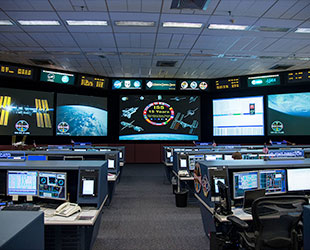
View inside the space station flight control room at the Johnson Space Center in Houston. Displayed on the front screen, images celebrating the International Space Station's 15 years. (NASA) |
NASA's Mission Control Center in Houston serves as the main ground support for the space station's U.S. operating segment (USOS). Likewise, Moscow Mission Control, also known as the TsUP, takes point for the outpost's Russian segment.
NASA's Payload Operations and Integration Center at the Marshall Space Flight Center in Alabama oversees U.S. experiments and coordinates partner investigations aboard the station.
Located in Oberpfaffenhofen, Germany (near Munich), the Columbus Control Center operates the Columbus lab and manages European science payloads. Similarly, the Kibo Control Center in Tsukuba Science City, Japan oversees JAXA's Kibo lab and the country's science experiments.
4
Robots and robotic arms
Humans are not the only residents on the station. The ISS also has robots aboard.
The outpost is outfitted with two robotic arms. Canadarm2, supplied (as its name suggests) by the Canadian Space Agency, was critical to assembling the space station and continues to support the orbital complex by latching onto and attaching or detaching unmanned resupply spacecraft as needed.
JAXA's Kibo laboratory has its own robotic arm, the JEM-RMS (Japanese Experiment Module Remote Manipulator System), used to tend to experiments mounted outside on the module's exposed platform (or porch).
Canada's Dextre — also known as the SPDM or Special Purpose Dexterous Manipulator — is a two-armed robot launched in 2008 to carry out tasks previously requiring a spacewalking astronaut.
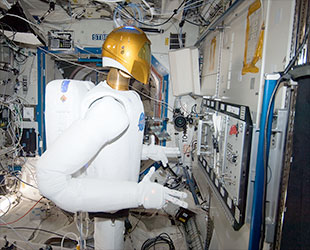
Robonaut 2, inside the space station's Destiny lab, is seen as it is commanded to operate valves on a task board. (NASA) |
And then there is Robonaut 2 (R2).
The product of a partnership between NASA and General Motors, R2 was the first humanoid robot to fly into space and first to be able to work side-by-side with astronauts. Capable of being controlled by the space station crew or by ground controllers, Robonaut 2 can use the same tools as used by humans.
3
Ways to exercise
Besides science experiment racks and sleep stations, the space station is also equipped with a gymnasium.
Exercising helps crew members limit the changes to their muscles, bones and cardiovascular system. It also helps them better adjust to gravity when they return to Earth.
Workout options on the station include specially-designed treadmills (including one named after comedian Stephen Colbert) that use a harness to hold the astronaut in place, an exercise bicycle, and a one-of-a-kind resistive exercise device.
The Advanced Resistive Exercise Device simulates free weights to help astronauts maintain their bone and muscle strength while in space.
2
Toilets
It's the most popular question asked of astronauts: how do you go to the bathroom in space?
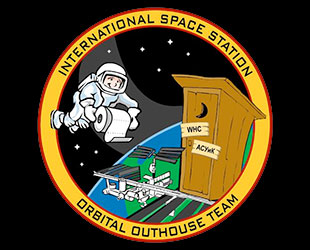
International Space Station "Orbital Outhouse Team" logo (NASA) |
The station is equipped with two toilets, one located in the Russian segment and other in the Tranquility node. Both use a fan-driven suction system to collect liquid and solid waste.
Solid waste is collected and jettisoned with other refuse aboard spent supply vehicles. Urine however, is recycled using an assembly that employs a low pressure vacuum and a centrifuge to distill the liquid.
"I like to call it the coffee machine," ISS Expedition 30/31 flight engineer Don Pettit said. "It'll take yesterday's coffee and turn it into today's coffee."
1
International Space Station
The International Space Station is the 10th space station in history to be launched into orbit, but is without parallel in size, scope and success.
And while there is only one International Space Station, it has come to serve multiple purposes.
"Our incredible station is many things," Charles Bolden, NASA's Administrator, said in a video statement released for the 15th anniversary. "It is our home in orbit where we are learning how to live and work in space for the long term, and perform research and demonstrate technologies that will help us reach an asteroid and Mars."
"It is integral to our exploration strategy," he added. "It is a unique global resource. Scientists from around the world can send their experiments to the station and astronauts from many countries demonstrate what's achievable when nations work together toward common goals that improve life everywhere."
